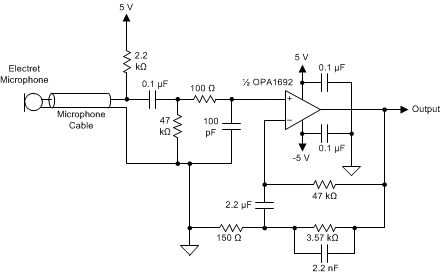SBOS566C June 2017 – October 2018 OPA1692
PRODUCTION DATA.
- 1 Features
- 2 Applications
- 3 Description
- 4 Revision History
- 5 Pin Configuration and Functions
- 6 Specifications
- 7 Detailed Description
- 8 Application and Implementation
- 9 Power Supply Recommendations
- 10Layout
- 11Device and Documentation Support
- 12Mechanical, Packaging, and Orderable Information
Package Options
Mechanical Data (Package|Pins)
Thermal pad, mechanical data (Package|Pins)
- DGK|8
Orderable Information
8.3.1 Two-Wire Electret Microphone Preamplifier
The circuit in Figure 60 can be modified to accommodate two-wire electret microphones, as shown in Figure 62. In two-wire configurations, there is no resistor in series with the source of the internal JFET of the microphone. The audio signal is output as a varying voltage across the biasing resistor (2.2 kΩ in Figure 62) of the capsule. The preamplifier input is AC-coupled to the biasing resistor through a 0.1-µF capacitor and 47-kΩ input resistor.
 Figure 62. Two-Wire Electret Microphone Preamplifier
Figure 62. Two-Wire Electret Microphone Preamplifier